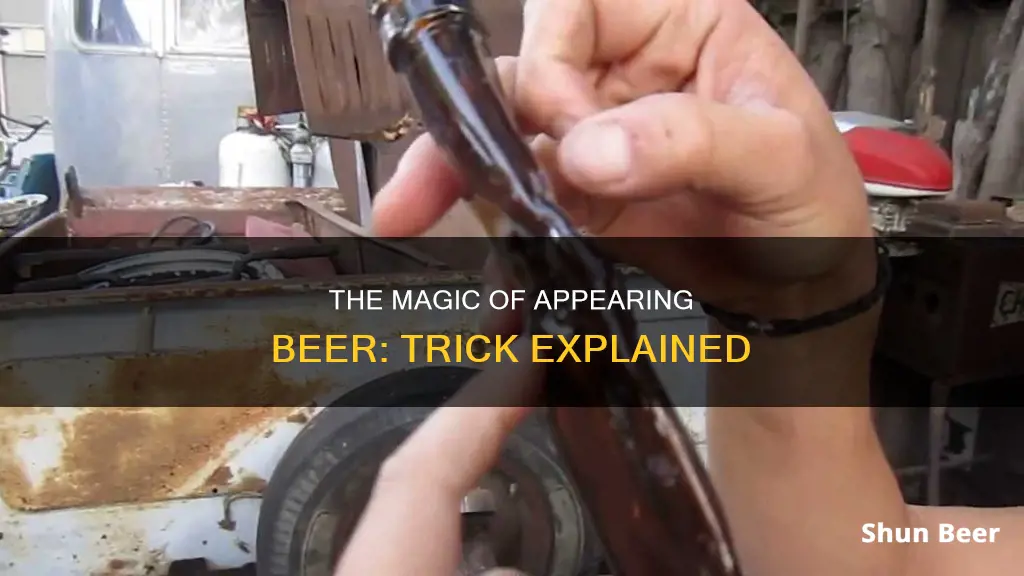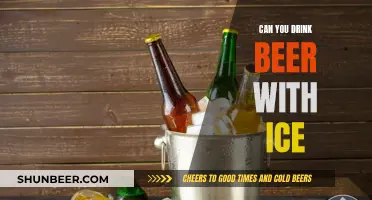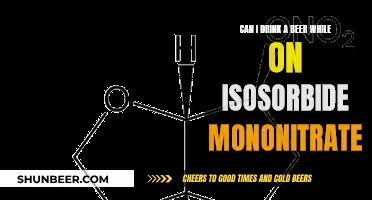
The appearing beer trick is a classic magic trick that has been performed by stage magicians for centuries. It is a variation of the inexhaustible bottle trick, which dates back to the 17th century. In the appearing beer trick, a magician produces an empty beer jar, covers it with a silk cloth, and then reveals a full jar of beer. The beer can then be poured into another glass, surprising the audience. This trick is often used as an opener for stand-up, street magic, or comedy shows, and it never fails to create a big reaction from the audience. While the method behind the trick may vary, it often involves simple mechanics and packs a big impact.
| Characteristics | Values |
|---|---|
| Name of the trick | Appearing Beer |
| Other names | Inexhaustible Bottle, Any Drink Called For, The Bar Act, Satan's Barman, The Assassin's Teapot, Think-a-Drink, The Obliging Tea Kettle, Magic Tea Kettle, Magic Funnel |
| Origin | 17th century |
| Originator | Unknown, but first appeared in Hocus Pocus Junior: The Anatomie of Legerdemain in London in 1635 |
| Props | Bottle, kettle, glasses, cocktail shakers, small bar |
| Effect | Magician produces a bottle or kettle and asks the audience to name any drink. The magician then pours out a glass of that drink, seemingly from the same bottle or kettle. |
| Variations | Magician rinses the bottle with water at the start of the act, breaking the bottle open at the end to reveal various objects |
What You'll Learn

The magician asks the audience to name a drink
The magician may then ask the audience to name another drink, and another, with the bottle seemingly producing an endless supply of different drinks on demand. This variation of the trick is known as the "endless pour", where a seemingly large or continuous amount of liquid is poured from a container that should not be able to hold it. The original method for this trick was a large barrel with internal baffles to create separate sections for different drinks.
Another variation of the trick, known as "Appearing Beer", involves showing an empty beer jar, covering it with a silk cloth, and then revealing a full jar of beer. This trick relies on a simple gimmick and a cloth to create a visual impact. The beer can then be poured into another glass, showing that it is, in fact, real liquid.
The Inexhaustible Bottle trick is a simple demonstration of hydrostatics, specifically Pascal's law, which states that any pressure applied to a continuous fluid is distributed evenly throughout the fluid. This principle allows the magician to control the flow of liquid and create the illusion of an endless supply of drinks.
The Science of Sipping: Beer Steins Explained
You may want to see also

The magician tips the bottle and pours out the requested drink
The magician might then ask for another drink, and another, and the bottle will seemingly produce the drinks on demand, forever. This is the "inexhaustible bottle" trick, a classic of stage magic that dates back to at least the 17th century. The magician might then break open the bottle to reveal various objects inside, such as coloured handkerchiefs, said to give the bottle its magical powers.
The trick is a simple demonstration of hydrostatics, specifically Pascal's law, which states that any pressure applied at any point in a continuous fluid is applied equally throughout the fluid. A corollary of this law is that a negative pressure is also equally distributed throughout the fluid, meaning that if a partial vacuum is applied at any point, the entire surface sees the same drop in pressure. This is how the magician is able to control the flow of liquid and create the illusion of an endless supply.
Does Helium Beer Work? The Science Behind It
You may want to see also

The magician repeats the trick with different drinks
The magician may then break the bottle open to reveal various objects, such as coloured handkerchiefs, which are said to give the bottle its magical powers. This is a slight variation on the original trick, known as the Magic Tea Kettle, which is widely available at magic shops and is often performed for children.
The trick is a simple demonstration of hydrostatics, specifically Pascal's law, which states that any pressure applied at any point in a continuous fluid is applied equally throughout the fluid. In the case of the inexhaustible bottle, the container has a large surface area in comparison to the relatively small tube leading from the bunghole. When the tube is sealed and the pouring cock at the bottom opened, a tiny amount of fluid will drain out until a vacuum is produced in the tube. This creates a difference in pressure that counteracts the force of gravity and stops the flow. To start the flow again, the hole at the top is uncovered, equalizing the pressure and allowing the liquid to pour out.
Beer Goggles: The Science Behind Alcohol's Effect on Attraction
You may want to see also

The bottle is broken open to reveal various objects
The "Inexhaustible Bottle" is a classic magic trick performed by stage magicians. The magician produces a bottle or kettle and asks the audience to name any sort of drink—water, beer, tea, or any other liquid. The magician then tips the bottle and pours out a glass of that drink. The magician asks for another drink, and another, and the bottle produces the drinks on demand, seemingly forever. At the end of the performance, the bottle is broken open to reveal various objects.
The trick dates back to at least the 17th century and has inspired many variations. Well-known examples include "Any Drink Called For", "The Bar Act", "Satan's Barman", and "Think-a-Drink". During the temperance movement, it became "The Obliging Tea Kettle", and the modern "Magic Tea Kettle" is a common prop available at most magic stores.
In the "Magic Tea Kettle" variation, a single kettle is poured into several cups, each of which turns a different color. This version often includes a flourish at the end, where the kettle is opened to reveal coloured handkerchiefs inside, which are said to give the kettle its magical powers.
The original method for the trick, as described in "Hocus Pocus Junior" in 1635, involved a large barrel that was modified with internal baffles to create three sections. A single spigot on one end of the barrel was extended with three pipes, each leading to a different partition. The flow of liquid was controlled through a bunghole on the top, which was modified to run to three hoses, one into each partition. By turning the stopper in the bunghole to uncover one of the pipes, air could flow into the selected partition. When the spigot was opened, only the liquid from that partition could flow out, as the partial vacuum in the other chambers prevented the flow.
The "Inexhaustible Bottle" trick is a simple demonstration of hydrostatics, specifically Pascal's law. Pascal's law states that any pressure applied at any point in a continuous fluid is applied equally throughout the fluid. In the case of the inexhaustible bottle, the container has a large surface area in comparison to the relatively small tube leading from the bunghole. When the tube is sealed and the spigot at the bottom is opened, a small amount of fluid will drain out until a vacuum is produced in the tube. This vacuum is then equally distributed throughout the fluid, counteracting the force of gravity and stopping the flow. To start the flow again, the hole at the top is uncovered to allow air into the chamber, equalizing the pressure.
Beer Subscriptions: How Do They Work?
You may want to see also

The trick is based on hydrostatics, specifically Pascal's law
The appearing beer trick, also known as the inexhaustible bottle, is a classic magic trick that has been performed by magicians for centuries. The trick involves a magician producing a bottle and asking the audience to name any drink, after which the magician proceeds to pour out a glass of the requested drink. The trick appears to defy logic as the bottle seems to contain an endless supply of liquid.
Pascal's Law, formulated by the French mathematician and philosopher Blaise Pascal in 1647, states that any pressure applied to the surface of a fluid is transmitted uniformly throughout the fluid in all directions. In the case of the inexhaustible bottle, the container has a large surface area compared to the small tube leading from the bunghole. When the tube is sealed and the bottle is inverted, the liquid initially flows due to gravity. However, as the liquid drains, a partial vacuum is created in the tube, resulting in a pressure drop throughout the fluid. This pressure difference counteracts the force of gravity, causing the flow to stop. When the hole at the top is uncovered, air enters the chamber, equalizing the pressure, and the liquid flows again.
By understanding and manipulating the principles of hydrostatics, magicians are able to create the illusion of an endless supply of liquid, captivating audiences and preserving the mystery of the appearing beer trick.
The Fizziness in Beer: How Carbonation Works
You may want to see also
Frequently asked questions
The appearing beer trick is a magic trick where a magician produces a beer jar or bottle, covers it with a silk cloth, and makes beer appear inside it.
The magician uses a small beer mug and a gimmick that is covered by a cloth. The gimmick prevents the beer from spilling when the magician makes it appear in the jar.
Some variations of the trick include using a different type of glass or jar, or adding a second hanky pass to make the glass appear full after starting with an empty jar.
The appearing beer trick is a variation of the classic "Inexhaustible Bottle" trick, which dates back to the 17th century. The original trick involved a magician producing a bottle or kettle and pouring out different drinks on demand, seemingly forever.







